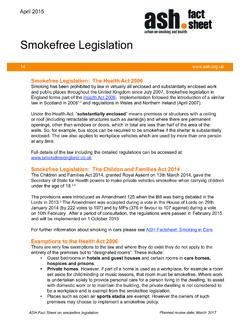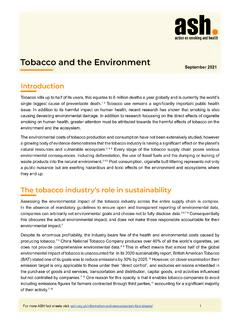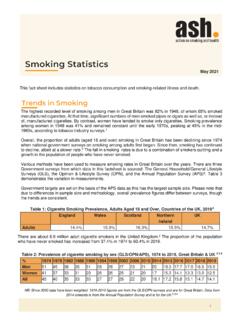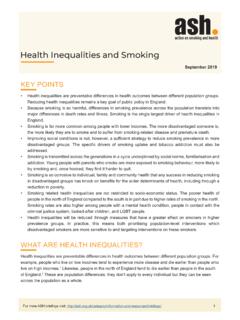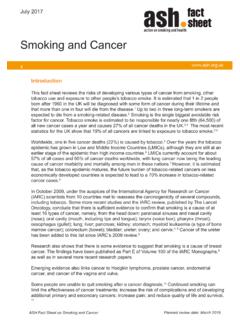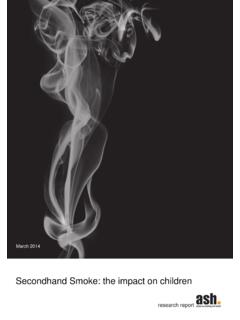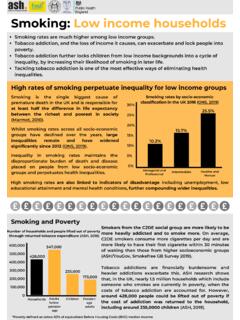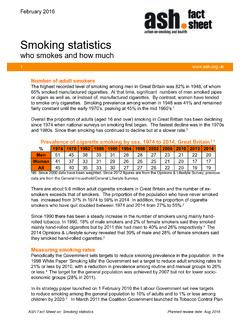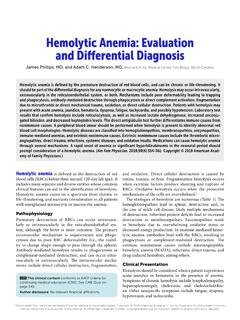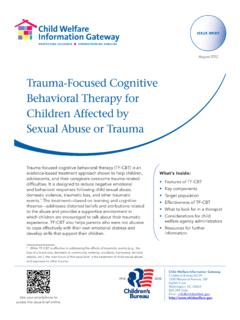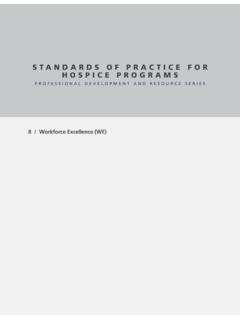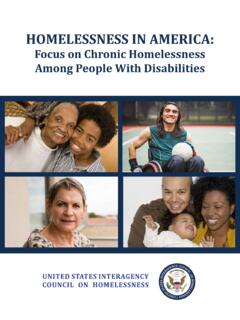Transcription of Young People and Smoking - Action on Smoking and Health
1 For more ASH briefings visit: 1 Young People and SmokingSMOKING PREVALENCEIt is estimated that each year around 207,000 children in the UK start Among adult smokers, about two-thirds report that they took up Smoking before the age of 18 and over 80% before the age of The 2011 General Lifestyle Survey of adult smokers revealed that almost two-fifths (40%) had started Smoking regularly before the age of The annual Government survey of Smoking among secondary school pupils in England defines regular Smoking as Smoking at least one cigarette per week. However, most pupils smoke considerably more than this, and in 2018 pupils classified as regular smokers smoked a mean (average) of cigarettes a week.
2 Occasional smokers, which includes Young People who describe themselves as non-smokers but smoke more than one cigarette per week, consumed on average cigarettes a The proportion of children who have ever smoked continues to decline. In 2018 , 16% of 11-15 year olds (23% in 2012) had smoked at least once; the lowest proportion since the survey began in 1982, when 53% had tried In the past decade, the proportion of children who have ever smoked has halved from 32% in 2008 to 16% in The prevalence of regular Smoking also increases with age, from 0% of 11 year olds to 5% of 15-year Percentage of regular smokers aged 11-15 by sex: 1982 2018 , EnglandYear19821986199019941998200220062 010201120122013201420162018 Boys1179109974443322 Girls111211131211106544432 Total11101012111095543332 Note: ONS estimates that in 2013 around 100,000 children aged 11-15 were regular smokers (CI=80,000-120,000).
3 About 20,000 fewer than in 2012. There is no data for 2015 due to funding cuts. September 2019 For more ASH briefings visit: 2 The decline in Smoking has been most marked among older pupils. The proportion of 14-year olds who smoked regularly fell from 9% in 2008 to 3% in 2018 ; among 15 year olds, fell from 14% in 2008 to 5% in of regular smokers aged 15: 1982 2018 , EnglandYears1982198619901994199820022006 2010201120122013201420162018 Boys241825261920161011108665 Girls252725302926241411108975 Total252225282423201211108875 EXPOSURE TO SECONDHAND SMOKEIn 2018 , a little over half (60%) of pupils reported having some level of exposure to secondhand smoke with 55% experiencing secondhand smoke in the home (theirs or others ).
4 4 Almost a quarter of pupils (23%) experienced secondhand smoke in a FACTORS INFLUENCE CHILDREN TO START Smoking ? Smoking initiation is associated with a wide range of risk factors including: parental and sibling Smoking , the ease of obtaining cigarettes, Smoking by friends and peer group members, socio-economic status, exposure to tobacco marketing, and depictions of Smoking in films, television and other Children who live with parents or siblings who smoke are up to three times more likely to become smokers themselves than children of non- Smoking It is estimated that, each year, at least 23,000 Young People in England and Wales start Smoking by the age of 15 as a result of exposure to Smoking in the Among regular smokers, 98% have friends who smoke, compared to 42% of non-smokers, and 78% of regular smokers have family members who smoke, compared to 64% of.
5 ALCOHOL AND DRUG USET here is a notable association between Smoking and other substance use. The 2018 survey found overlaps between Smoking and other substance abuse. Compared to 1% of students who only smoked, 1% both smoked and took drugs, and 2% smoked, drank alcohol and took OTHER FACTORS ASSOCIATED WITH SMOKINGThe 2012 survey found that Young People who played truant from school or who had been excluded from school in the previous 12 months were almost twice as likely to smoke regularly compared to those who had never been truant or For more ASH briefings visit: 3 ATTITUDES TO SMOKINGThe proportion of pupils who think it is acceptable to try Smoking has decreased since the question was first asked in 1999.
6 Currently, 24% believe it is acceptable to try Smoking to see what it is like compared with 54% in 1999. Only 9% thought it was OK to smoke once a In the 2018 survey children were asked for their views on why Young People smoked. Children who were non-smokers believed their peers smoked to look cool in front of their friends (80%), because they were addicted (71%) and because their friends pressure them into it (69%). Young People who were regular smokers said they smoked because it helped them cope with stress (95%), because Smoking helps them relax (82%) and because they were addicted (80%).4 Smoking AND CHILDREN S HEALTHThe younger the age of uptake of Smoking , the greater the harm is likely to be, because early uptake is associated with subsequent heavier Smoking , higher levels of dependency, a lower chance of quitting, and higher Child and adolescent Smoking causes serious risks to respiratory Health both in the short and long term.
7 Children who smoke are two to six times more susceptible to coughs and increased phlegm, wheeziness and shortness of breath than those who do not Smoking impairs lung growth and initiates premature lung function decline which may lead to an increased risk of chronic obstructive lung disease later in life. The earlier children become regular smokers and persist in the habit as adults, the greater the risk of developing lung cancer or heart Children are also more susceptible to the effects of passive Smoking . Parental Smoking is the main determinant of exposure in non- Smoking children. Although levels of exposure in the home have declined in the UK in recent years, children living in the poorest households have the highest levels of exposure as measured by cotinine, a marker for Bronchitis, pneumonia, asthma and sudden infant death syndrome (cot death) are significantly more common in infants and children who have one or two Smoking parents.
8 For more information see: ASH Research Report: Passive Smoking : The impact on children ASH Factsheets: Smoking in the Home, Smoking in Cars For more ASH briefings visit: 4 ADDICTIONC hildren who experiment with cigarettes can quickly become addicted to the nicotine in tobacco. Children may show signs of addiction within four weeks of starting to smoke and before they commence daily One US study found that Smoking just one cigarette in early childhood doubled the chance of a teenager becoming a regular smoker by the age of A UK study suggests that Smoking a single cigarette is a risk indicator for children to become regular smokers up to three years In the 2016 survey of school-children in England, 47% of Young People who have smoked for under one year say they would find it difficult to stop for one week compared to 70% for those who have smoked more than one During periods of abstinence.
9 Young People experience withdrawal symptoms similar to the kind experienced by adult 13 Smoking PREVENTIONR esearch suggests that knowledge about Smoking is a necessary component of anti- Smoking campaigns but by itself does not affect Smoking rates. It may, however, result in a postponement of High prices can deter children from Smoking , since Young People do not possess a large disposable income: studies suggest Young People may be up to three to four times more price sensitive than In Canada, when cigarette prices were raised dramatically in the 1980s and the early 1990s youth consumption of tobacco plummeted by 60%.16 An American study has shown that while price does not appear to affect initial experimentation of Smoking , it is an important tool in reducing youth Smoking once the habit has become The National Institute for Health and Care Excellence (NICE) has issued guidance on school-based interventions to prevent the uptake of Smoking among In 2016, 25% of regular smokers wanted to give up Smoking , and 51% of children had attempted to give For more ASH briefings visit: 5 CHILDREN, Smoking AND THE LAWThe Government has implemented many measures designed to deter children from Smoking .
10 Legislation alone is not sufficient to prevent tobacco sales to minors. Both enforcement and community policies may improve compliance by retailers but the impact on underage Smoking prevalence using these approaches alone may still be Successful efforts to limit underage access to tobacco require a combination of approaches that tackle the problem OCTOBER 2007 The legal age for the purchase of tobacco in England and Wales was raised from 16 to 18. This measure was designed to make it more difficult for teenagers to obtain cigarettes, since, despite the law, children still succeeded in buying tobacco from shops and vending machines. In 2008, the first time data was collected after the change in the law, 39% of pupils who smoked said they found it difficult to buy cigarettes from shops.

